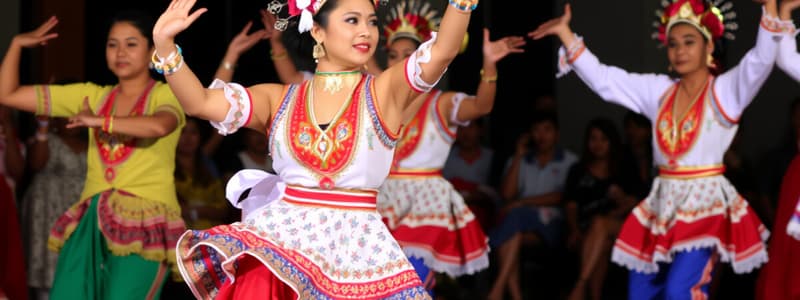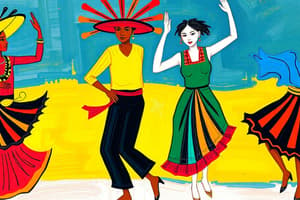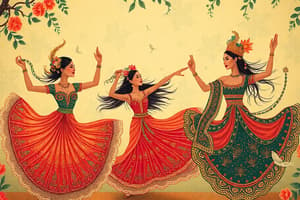Podcast
Questions and Answers
Which movement best describes a transfer of weight with a spring, landing on the ball of one foot?
Which movement best describes a transfer of weight with a spring, landing on the ball of one foot?
- Jump
- Gallop
- Hop (correct)
- Slide
What is the primary distinction between locomotor and non-locomotor movements?
What is the primary distinction between locomotor and non-locomotor movements?
- Non-locomotor movements involve jumps and hops, while locomotor movements do not.
- Non-locomotor movements occur in place, while locomotor movements require space. (correct)
- Locomotor movements use weight transfer while non-locomotor do not.
- Locomotor movements are faster than non-locomotor movements.
Which movement involves a quick close of one foot behind or beside the leading foot?
Which movement involves a quick close of one foot behind or beside the leading foot?
- Jump
- Slide
- Run
- Gallop (correct)
In what way does a leap differ from a jump?
In what way does a leap differ from a jump?
Which term describes movements performed in place, predominantly involving body part manipulations?
Which term describes movements performed in place, predominantly involving body part manipulations?
What is a common feature of galloping as a locomotor movement?
What is a common feature of galloping as a locomotor movement?
What distinguishes a jump from a leap in movement terms?
What distinguishes a jump from a leap in movement terms?
Which of the following best describes the rhythm of a slide movement?
Which of the following best describes the rhythm of a slide movement?
Which of the following is an example of an Occupational Dance?
Which of the following is an example of an Occupational Dance?
What characterizes War Dances in Philippine folk dance?
What characterizes War Dances in Philippine folk dance?
Which type of dance involves elements of humor and entertainment?
Which type of dance involves elements of humor and entertainment?
How are National Dances classified in the context of Philippine folk dance?
How are National Dances classified in the context of Philippine folk dance?
Which of the following dances is characterized as a Wedding Dance?
Which of the following dances is characterized as a Wedding Dance?
In which category would you classify the dance 'Sinulog'?
In which category would you classify the dance 'Sinulog'?
Identify the dance that is NOT categorized as a Festival Dance.
Identify the dance that is NOT categorized as a Festival Dance.
Which of the following dances is traditionally associated with the theme of courtship?
Which of the following dances is traditionally associated with the theme of courtship?
Study Notes
Classification of Philippine Folk Dance
Geographical Locations
- National Dances: Traditional dances found throughout the Philippines with slight regional variations. Examples include:
- Cariñosa
- Kuratsa
- Balitaw
- Rigodon Pandango Surtido
- Local or Regional Dances: Specific to certain areas. Notable examples are:
- Alcamfor (Leyte)
- Maglalatik (San Pablo, Laguna)
- Basulto (Pampanga)
Nature of the Dance
- Occupational Dances: Represents occupations and human labor phases. Common examples:
- Rice Festival — involves multiple dances
- Pagtatanim (planting)
- Paggapas (harvesting)
- Paggik (threshing)
- Paglulugas (washing)
- Paghangin (airing)
- Pagbabayo (pounding)
- Pabirik (gold panning)
- Mananguete (gathering tuba)
- Religious or Ceremonial Dances: Linked to religious practices or ceremonies like:
- Obando
- Dugso
- Sinulog
- Courtship Dances: Focus on love and romance, with examples such as:
- Rogelia
- Lulay
- Hele-Hele Bago Quiere
- Wedding Dances: Celebrate marriage, performed by newlyweds and their families. Examples:
- Pantomina (bride and groom)
- Pandang-Pandang (friends and relatives)
- Soryano (parents visiting bride’s family)
- Festival Dances: Celebrate feasts and harvests. Common examples include:
- Kuratsa
- La Jota
- Putong
- War Dances: Portray imaginary combat, using props like bolo or spear. Examples:
- Inabaknon
- Sagayan
- Comic Dances: Humorous movements intended primarily for entertainment, such as:
- Makonggo (simulating monkey movements)
- Kinoton (reflecting movements of someone bitten by ants)
- Game Dances: Recreational dances that include play elements. Examples:
- Lubi-lubi
- Gayong-gayong
- Pabo
- Social Dances: Performed at social gatherings, notable examples include:
- Rigodon
- Lanceros
Benefits of Dancing
- Fitness: Promotes physical health through exercise and expression.
- Joy and Satisfaction: Enhances physical well-being and mental joy of participants.
- Grace and Coordination: Improves rhythmic responses and neuromuscular coordination.
- Self-Expression: Develops poise, posture, and confidence.
Basic Movement Skills
- Categories: Two main types—locomotor and non-locomotor movements.
- Locomotor Movements:
- Include walking, running, jumping, leaping (even rhythmic), and galloping, sliding, skipping (uneven rhythmic).
- Non-Locomotor Movements:
- Involve bending, stretching, swaying, swinging, clapping, shaking, pushing, pulling, falling, and rising.
- Locomotor Movements:
- Key Details:
- Walk: Shift weight from one foot to the other.
- Run: Faster tempo compared to walking, weight transferred similarly.
- Hop: Bounce on one foot, landing on the ball of the same foot.
- Jump: Spring on one or both feet, landing on both.
- Leap: Transfer weight from one foot to the other with springing motion for height/distance.
- Gallop: Step on one foot followed by a close step with the other; rhythmic pattern.
- Slide: Move slowly to one side, quickly shifting weight onto the other foot.
Studying That Suits You
Use AI to generate personalized quizzes and flashcards to suit your learning preferences.
Description
Explore the rich diversity of Philippine folk dances through this quiz. Learn about national and regional dances, as well as those tied to occupations, religion, and courtship. Test your knowledge on the cultural significance and variations of these traditional dances across the Philippines.




